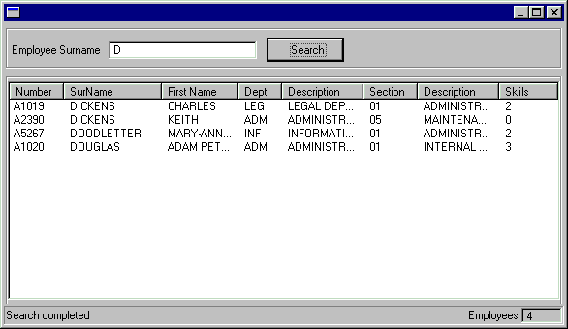Tier Aware Subroutines with List Parameters
Example 147 - Rating: advanced
Example 147 - Rating: advanced
| The Things that Make Up this Example | To Execute this Example |
This form (VL_SAM147) acts as a simple interface to the tier aware subroutine VSAM146.
The returned list contains not only basic employee details but also a full description of the department and section the employee works in (requiring table DEPTAB and SECTAB access) and a count of the number of skills associated with the employee (requiring table PSLSKL access).
The production of this returned list is thus quite an expensive operation (this example has been specifically designed to accentuate the performance differences between the thick and thin client modes of execution).
VSAM146 demonstrates these features:
The easiest way to understand all of the preceding points is to cut/paste/compile the examples and then combine execution of them with reading of the comments contained within them.
Keywords

The returned list contains not only basic employee details but also a full description of the department and section the employee works in (requiring table DEPTAB and SECTAB access) and a count of the number of skills associated with the employee (requiring table PSLSKL access).
The production of this returned list is thus quite an expensive operation (this example has been specifically designed to accentuate the performance differences between the thick and thin client modes of execution).
VSAM146 demonstrates these features:
- Some programming techniques that can be used in tier managed subroutines.
- Use of the APPL (application) and DATA (database) tiers.
- How the use of a tier management scheme can change the performance characteristics of an application.
- Techniques for passing long lists between application tiers.
The easiest way to understand all of the preceding points is to cut/paste/compile the examples and then combine execution of them with reading of the comments contained within them.
Keywords
| Tier | Management |
| Multi-Tier | Remote Procedure |
| Database | Client |
| Server | n-Tier |
| Subroutine | List |
| Example 147 |